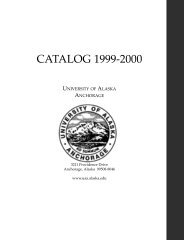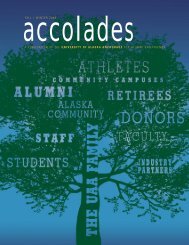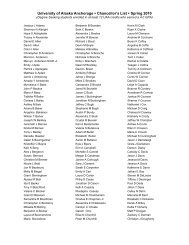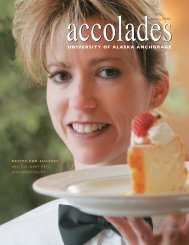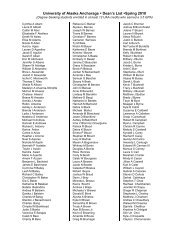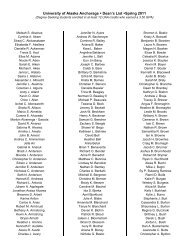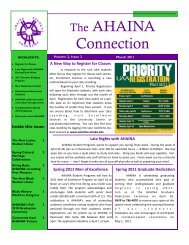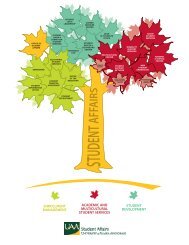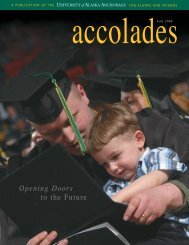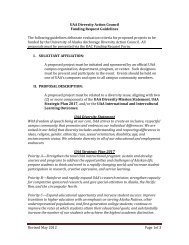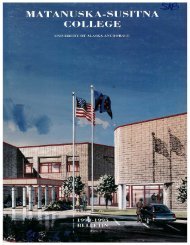Professional Counselor Portfolio - University of Alaska Anchorage
Professional Counselor Portfolio - University of Alaska Anchorage
Professional Counselor Portfolio - University of Alaska Anchorage
Create successful ePaper yourself
Turn your PDF publications into a flip-book with our unique Google optimized e-Paper software.
<strong>Pr<strong>of</strong>essional</strong> <strong>Counselor</strong> <strong>Portfolio</strong> (Community Agency Option) (revised spring 2010)<br />
Introduction<br />
What is a pr<strong>of</strong>essional counselor portfolio? A portfolio is a vehicle for demonstrating an<br />
integration <strong>of</strong> knowledge and skills obtained during graduate study. It has been defined<br />
in the pr<strong>of</strong>essional literature as a “purposeful collection <strong>of</strong> student work that tells the<br />
story <strong>of</strong> the student’s effort, progress, or achievements in a given area” (Arter & Spandel,<br />
1992, p. 36). <strong>Portfolio</strong>s encourage students to provide concrete evidence <strong>of</strong> awareness,<br />
knowledge, and skills in counseling. As a result, the portfolio process assists students “in<br />
becoming more self-reflective in their learning, taking greater ownership <strong>of</strong> their<br />
learning, process, and showing what they have learned to others” (Coleman, 1996, p.<br />
218).<br />
The portfolio method has been used for more than two decades as a means <strong>of</strong> training and<br />
monitoring progress <strong>of</strong> prospective teachers (Baltimore, Hickson, George, & Cruthfield,<br />
1996). Hurst, Wilson, and Cramer (1998) noted that pr<strong>of</strong>essional teaching portfolios are<br />
effective because they serve as visual representations <strong>of</strong> talent and a reflective collection<br />
<strong>of</strong> pr<strong>of</strong>essional competence. Another benefit <strong>of</strong> this method is that portfolios can serve as<br />
alternatives or supplements to pen-and-paper assessment tests (Coleman, 1996).<br />
There has been discussion in the pr<strong>of</strong>essional literature on the use <strong>of</strong> pr<strong>of</strong>essional<br />
portfolios by counselors for the purpose <strong>of</strong> accountability and pr<strong>of</strong>essional development<br />
as well as an evaluation tool in counselor education programs (Baltimore, et al., 1996;<br />
Borders & Leddick, 1987; Carney, Cobia, & Shannon, 1996; Rhyne-Winkler, & Wooten,<br />
1996). For example, Boes, Van Zile-Tamsen, Cobia, and Jackson (2001) described how<br />
potential counselor can enhance job opportunities by displaying course materials in a<br />
portfolio.<br />
The recent focus on portfolios suggests that the method may be worthy <strong>of</strong> consideration<br />
as an essential component <strong>of</strong> evaluation in counseling programs. In fact, an increasing<br />
number <strong>of</strong> counselor education programs are requiring portfolios as a capstone<br />
experience. <strong>Counselor</strong> education programs such as Old Dominion <strong>University</strong> (2008),<br />
SUNY Oneonta (2008), the <strong>University</strong> <strong>of</strong> Southern Main (2008), and Delta State<br />
<strong>University</strong> (2008) all require students to provide documentation that they attained the<br />
knowledge and skills that define a pr<strong>of</strong>essional counselor.<br />
Several models have been published that suggest specific areas that should be addressed<br />
in the portfolio. For example, Rhyne-Winkler and Wooten (1996) suggested following<br />
the performance indicators for counselors that are parallel to state requirements for<br />
licensure and certification. Baltimore, et al. (1996), and Carney, et al. (1996) suggested
that domains and components should be reflective <strong>of</strong> the foundation areas identified by<br />
the Council for the Accreditation <strong>of</strong> Counseling and Related Educational Programs<br />
(CACREP). It should be noted that the CACREP foundations areas parallel the course<br />
work requirement as mandated by the National Board <strong>of</strong> Certified <strong>Counselor</strong>s (NBCC)<br />
for the purpose <strong>of</strong> admission to complete the National Certification and Licensure Exam<br />
(NCLE). Successful passage <strong>of</strong> this exam is required for consideration <strong>of</strong> the designation<br />
National Certified <strong>Counselor</strong> (NCC). A further note is that the <strong>Alaska</strong> Board for<br />
Licensed <strong>Pr<strong>of</strong>essional</strong> <strong>Counselor</strong>s requires successful completion <strong>of</strong> the NCLE as well.<br />
Is there empirical pro<strong>of</strong> that any approach is more effective? Alschuler (1996) pointed<br />
out that there is no scientific evidence that any portfolio design has proven to be an<br />
effective tool when used in solitude to assess student competence. Difficulty in<br />
standardizing the content, scope, format, and data collection is a noted disadvantage in<br />
using portfolios as a sole predictive instrument. Alschuler, after reviewing more than 100<br />
research abstracts, did note that using the portfolio as an evaluative tool in addition to<br />
traditional procedures such as course assignments and exams does have value. As noted<br />
by Baltimore et al. (1996), “portfolios represent a more genuine and authentic form <strong>of</strong><br />
assessment because they measure learning outcomes directly through demonstration and<br />
performance. Additionally, they serve to integrate the learning experienced by students<br />
across course work in the degree programs” (p. 113). Alschuler (p. 134) stated some<br />
general advantages appear to be that the portfolio:<br />
Measures directly what counselors should know and should be able to do;<br />
valuable outcomes in their own right.<br />
Demonstrates how discrete knowledge and skills are integrated and applied in real<br />
contexts.<br />
Allows flexibility and individualization how each person is assessed.<br />
Requires extensive, continual self-reflection.<br />
Encourages ongoing assessment, measurement <strong>of</strong> growth and updated educational<br />
plans.<br />
Provides useful evidence in getting jobs.<br />
Generates greater satisfaction and less anxiety for students.<br />
What part do portfolios play in the <strong>Counselor</strong> Education Program? The <strong>Counselor</strong><br />
Education Program at the <strong>University</strong> <strong>of</strong> <strong>Alaska</strong> <strong>Anchorage</strong> has adopted the portfolio as<br />
the capstone experience for demonstrating attainment <strong>of</strong> program outcomes. The<br />
pr<strong>of</strong>essional portfolio has also been approved by the College <strong>of</strong> Education and the<br />
<strong>University</strong> to serve as the culminating academic activity.<br />
The program outcomes are:<br />
Communicate essential knowledge and understandings <strong>of</strong> the pr<strong>of</strong>ession <strong>of</strong><br />
counseling including an ability to integrate knowledge into personally meaningful<br />
frameworks.<br />
o The counselor exhibits foundational knowledge <strong>of</strong> the pr<strong>of</strong>ession <strong>of</strong> counseling including critical events,<br />
credentialing, individual counseling theories, group counseling dynamics and theories, and career counseling<br />
theories. The counselor articulates a personal orientation to counseling that is congruent with literature in the field.<br />
Apply practical knowledge that is developmentally appropriate to individuals and<br />
groups.
o The counselor understands child growth and development, including expected and exceptional stages and the<br />
implications <strong>of</strong> development for counseling practices. The counselor applies effective counseling practices including<br />
use <strong>of</strong> non-verbal and verbal techniques as well as adaptive theoretical strategies to a range <strong>of</strong> client situations. The<br />
counselor accurately analyzes case studies.<br />
Utilize assessment, research, and technology to support and improve counseling<br />
practices.<br />
o The counselor understands legal issues related to assessment and has knowledge and skills to implement a<br />
comprehensive program <strong>of</strong> assessment, evaluation, reporting to optimize client services. The counselor engages in<br />
practical research including counseling program evaluation. The counselor utilizes technology in the effective<br />
delivery <strong>of</strong> counseling services.<br />
Show characteristics relating to effective counseling practice.<br />
o The counselor exhibits the pr<strong>of</strong>essional characteristics necessary for the effective work in the counseling field<br />
including empathy, warmth, flexibility, congruence, maturity, and the ability to deal with ambiguity.<br />
Create positive therapeutic environments for all clients.<br />
o The counselor understands the importance <strong>of</strong> valuing individual differences, including cultural and social diversity, in<br />
educational and community settings and programs. The counselor is competent in developing therapeutic<br />
environments that facilitate the healthy social, emotional, physical, cultural, and academic growth <strong>of</strong> clients.<br />
Engage in work that meets ethical standards and legal mandates in the field <strong>of</strong><br />
counseling.<br />
o The counselor is aware <strong>of</strong>, and abides by, the highest standards <strong>of</strong> ethical and pr<strong>of</strong>essional practice. The counselor<br />
is cognizant <strong>of</strong> federal and state laws that govern the counseling pr<strong>of</strong>ession including suspected abuse reporting<br />
laws and procedures.<br />
Students will turn the outcomes into personalized goals. Students will create unique<br />
artifacts that will demonstrate their attainment <strong>of</strong> the goals. In addition to the<br />
individualized artifacts, all students will submit standardized work pieces. The<br />
standardized artifacts are a case study analysis and a <strong>Pr<strong>of</strong>essional</strong> Counseling Statement<br />
paper. Students will present their portfolios during practicum/internship to their peers,<br />
instructors, and practicing counselors.<br />
Conclusion<br />
It appears that the use <strong>of</strong> portfolios in academic settings is becoming more a reality than<br />
rhetoric (Ritchie, 1989). <strong>Portfolio</strong>s are at their best when they allow students to shine.<br />
Powerful portfolios will allow students to have input in the design and presentation <strong>of</strong> the<br />
work. Whatever form for portfolio domains is adopted, flexibility in terms <strong>of</strong> portfolio<br />
development needs to be the philosophical base. <strong>Portfolio</strong>s are unique to each student<br />
and dynamically unfold as the student progresses through the educational program<br />
(McCulloch, 2005). Students bring to the portfolio process their individual philosophies,<br />
experiences, and talents. Thus, each portfolio represents an individual pursuit <strong>of</strong><br />
pr<strong>of</strong>essional excellence.<br />
<strong>Counselor</strong> Education <strong>Pr<strong>of</strong>essional</strong> <strong>Portfolio</strong> Domains<br />
Community Agency Option<br />
Candidates seeking the Master <strong>of</strong> Education in <strong>Counselor</strong> Education degree are expected<br />
to demonstrate knowledge, skills, and dispositions congruent with the program’s<br />
outcomes. The following format contains lists each <strong>of</strong> the program’s goals and required<br />
artifacts that will document attainment <strong>of</strong> the goals. Candidates are to create at least one<br />
personalized goal and a corresponding artifact that will demonstrate completion <strong>of</strong> the<br />
goal.
Program Goal 1: Communicate essential knowledge and understandings <strong>of</strong> the<br />
pr<strong>of</strong>ession <strong>of</strong> counseling including an ability to integrate knowledge into personally<br />
meaningful frameworks.<br />
Candidate Goal 1:<br />
Example: I will understand the day-to-say practices <strong>of</strong> a crisis intervention counselor<br />
Required Artifacts:<br />
1.1 Site Supervisor Evaluation<br />
1.2 UAA Instructor Observation Evaluation<br />
1.3 <strong>Pr<strong>of</strong>essional</strong> Counseling Statement<br />
1.4 Candidate Artifact:<br />
Example: Monthly calendar <strong>of</strong> counselor duties<br />
Program Goal 2: Apply practical knowledge that is developmentally appropriate to<br />
individuals and groups.<br />
Candidates in EDCN A634 Counseling Practicum must use formal assessment<br />
processes to document effectiveness in ONE <strong>of</strong> the areas <strong>of</strong>, personal development,<br />
social development, or career development. Examples <strong>of</strong> assessment includes using a<br />
pre-test and post-test to analyze student learning in higher education; client satisfaction<br />
survey, using scores from standardized tests to design and analyze counseling<br />
interventions; designing, administrating, and/or analyzing the results <strong>of</strong> a client needs<br />
survey.<br />
Candidates in EDCN A695C Counseling Internship: Community Agency<br />
The candidate must use formal assessment processes to document effectiveness in<br />
EACH <strong>of</strong> the areas <strong>of</strong> personal development, social development, and career<br />
development.<br />
Candidate Goal 2a:<br />
Example: I will demonstrate my ability to improve the coping skills <strong>of</strong> survivors <strong>of</strong><br />
incest.<br />
Candidate Goal 2b:<br />
Example: I will demonstrate the ability to lead a small counseling group with<br />
recovering substance abusers.<br />
Candidate Goal 2c:<br />
Example: I will demonstrate the ability to assist college freshmen with academic<br />
planning.<br />
Required Artifacts:<br />
2.1 Site Supervisor Evaluation<br />
2.2 UAA Instructor Observation Evaluation
2.3 Signed Practicum/Internship Logs<br />
2.4 Candidate Artifact:<br />
Examples: 2a Results from an administered structured assessment (e.g., Beck’s<br />
Depression Scale)<br />
2b: Results <strong>of</strong> a pre-test and post-test for the group<br />
2c: Results from five college freshmen satisfaction surveys entitled, “My Satisfaction<br />
with Academic Planning”<br />
Program Goal 3: Utilize assessment, research, and technology to support and improve<br />
counseling practices.<br />
Candidate Goal 3:<br />
Example: I will articulate my ability to use assessment data to improve counseling<br />
programs by analyzing the pre-test and post-test results <strong>of</strong> my counseling group.<br />
Required Artifacts:<br />
3.1 Site Supervisor Evaluation<br />
3.2 Candidate Self-Evaluation<br />
3.3 Candidate Artifact:<br />
Example: Excel spreadsheet <strong>of</strong> data and narrative <strong>of</strong> interpretation<br />
Goal 4: Show characteristics relating to effective counseling practice.<br />
Example: I will analyze resources on counseling techniques for women with ADHD.<br />
Candidate Goal 4:<br />
Required Artifacts:<br />
4.1 Site Supervisor Evaluation<br />
4.2 Candidate Self-Evaluation<br />
4.3 UAA Instructor Observation Evaluation<br />
4.4 Signed Practicum/Internship Logs<br />
4.5 Candidate Artifact:<br />
Example: Created resource booklet for counselors<br />
Goal 5: Create positive therapeutic environments for all clients.<br />
Example: I will communicate rapport with a client from a culture that is different from<br />
my own.<br />
Candidate Goal 5:<br />
Required Artifact:<br />
5.1 Site Supervisor Evaluation<br />
5.2 Candidate Self-Evaluation<br />
5.3 UAA Instructor Observation Evaluation
5.4 Client/Parent/Co-Worker Evaluation<br />
5.5 Candidate Artifact:<br />
Example: Client satisfaction survey<br />
Goal 6: Engage in work that meets ethical standards and legal mandates in the field <strong>of</strong><br />
counseling.<br />
Example: I will communicate my understanding <strong>of</strong> the legal mandate to report<br />
suspected child abuse<br />
Candidate Goal 6:<br />
Required Artifact:<br />
6.1 Site Supervisor Evaluation<br />
6.2 Candidate Self-Evaluation<br />
6.3 UAA Instructor Observation Evaluation<br />
6.4 Case Study Analysis (Waived for candidates who took the Comprehensive<br />
Examination)<br />
6.5 Candidate Artifact:<br />
Example: Agency reporting with identifying data removed<br />
Community Agency Counseling Standards<br />
Additionally, candidates pursuing the options <strong>of</strong> community agency should demonstrate<br />
competence in community counseling practices. Candidates in EDCN A695C<br />
Counseling Internship: Community Agency should select two to four <strong>of</strong> the following<br />
standards and create personalized goals for the internship. Candidates are to work with<br />
their site supervisors to identify appropriate standards for creating personalized goals and<br />
artifacts that will demonstrate competence in the selected areas.
The full descriptions <strong>of</strong> the performance standards for community counselors can be<br />
found in the Council for Accredited Counseling and Related Education Programs<br />
Standards Draft #3 (Pages 28-33, Clinical Mental Health) at<br />
http://www.cacrep.org/2009CACREPstandardsrevision-Draft3final.doc<br />
CACREP Standard 1: Foundations <strong>of</strong> community agency counseling including roles and<br />
functions <strong>of</strong> the counselor.<br />
Candidate Goal 1:<br />
Artifact 1:<br />
CACREP Standard 2: Counseling including individual and group services for the<br />
purpose <strong>of</strong> relieving client distress.<br />
Candidate Goal 2:<br />
Artifact 2:<br />
CACREP Standard 3: Prevention including activities for the purpose <strong>of</strong> decreasing<br />
likelihood <strong>of</strong> client developing mental illness.<br />
Candidate Goal 3:<br />
Artifact 3:<br />
CACREP Standard 4: Intervention including designing and delivering strategies for<br />
dealing with acute client distress (e.g., crisis intervention, suicide intervention)<br />
Candidate Goal 4:<br />
Artifact 4:<br />
CACREP Standard 5: Assessment including case conceptualization.<br />
Candidate Goal 5:<br />
Artifact 5:<br />
CACREP Standard 6: Diagnosis including use <strong>of</strong> tools such as the Diagnostic and<br />
Statistical Manual <strong>of</strong> Mental Disorders (DSM).<br />
Candidate Goal 6:<br />
Artifact 6:
CACREP Standard 7: Diversity & Advocacy including effective techniques for working<br />
with a variety <strong>of</strong> populations.<br />
Candidate Goal 7:<br />
Artifact 7:<br />
CACREP Standard 8: Research and Evaluation including techniques for evaluating<br />
counseling services and program effectiveness.<br />
Candidate Goal 8:<br />
Artifact 8:




